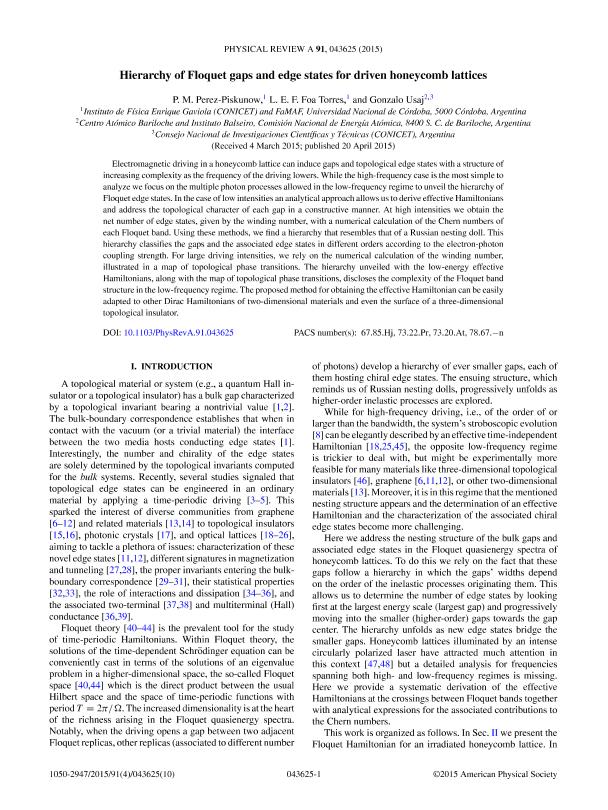Artículo
Hierarchy of Floquet gaps and edge states for driven honeycomb lattices
Fecha de publicación:
20/04/2015
Editorial:
American Physical Society
Revista:
Physical Review A: Atomic, Molecular and Optical Physics
ISSN:
1050-2947
Idioma:
Inglés
Tipo de recurso:
Artículo publicado
Clasificación temática:
Resumen
Electromagnetic driving in a honeycomb lattice can induce gaps and topological edge states with a structure of increasing complexity as the frequency of the driving lowers. While the high frequency case is the most simple to analyze we focus on the multiple photon processes allowed in the low frequency regime to unveil the hierarchy of Floquet edge-states. In the case of low intensities an analytical approach allows us to derive effective Hamiltonians and address the topological character of each gap in a constructive manner. At high intensities we obtain the net number of edge states, given by the winding number, with a numerical calculation of the Chern numbers of each Floquet band. Using these methods, we find a hierarchy that resembles that of a Russian nesting doll. This hierarchy classifies the gaps and the associated edge states in different orders according to the electron-photon coupling strength. For large driving intensities, we rely on the numerical calculation of the winding number, illustrated in a map of topological phase transitions. The hierarchy unveiled with the low energy effective Hamiltonians, alongside with the map of topological phase transitions discloses the complexity of the Floquet band structure in the low frequency regime. The proposed method for obtaining the effective Hamiltonian can be easily adapted to other Dirac Hamiltonians of two dimensional materials and even the surface of a 3D topological insulator.
Palabras clave:
Driven Quantum Systems
,
Floquet Topological Insulators
,
Graphene
Archivos asociados
Licencia
Identificadores
Colecciones
Articulos(CCT - PATAGONIA NORTE)
Articulos de CTRO.CIENTIFICO TECNOL.CONICET - PATAGONIA NORTE
Articulos de CTRO.CIENTIFICO TECNOL.CONICET - PATAGONIA NORTE
Citación
Pérez Piskunow, Pablo Matías; Foa Torres, Luis Eduardo Francisco; Usaj, Gonzalo; Hierarchy of Floquet gaps and edge states for driven honeycomb lattices; American Physical Society; Physical Review A: Atomic, Molecular and Optical Physics; 91; 4; 20-4-2015; 43625-1 / 43625-10
Compartir
Altmétricas




